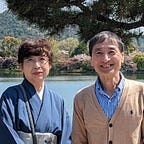An Intimate Exploration into Kyoto: Serene Solitudes & Timeless Tales
— Article 15: Leaflets in Yase and Ohara —
In northeast Kyoto, cloaked in the understated elegance of nature, lie Yase and Ohara, regions I had the fortune to explore in April 2022. This visit coincided with a mesmerizing spectacle: temples and hills adorned with a tapestry of leaflets.
Nestled in Yase, Rurikoin remains a hidden gem, revered by locals yet largely undiscovered by the tourist throng. My first encounter with this sanctuary was through an anecdote shared in a quaint Japanese bar, a tale I recounted in the inaugural article of this series. The ineffable beauty of Rurikoin’s leaflets, which I witnessed on April 17th, transcends linguistic expression.
A subsequent visit to Rurikoin on August 14th revealed a contrasting splendor. The verdant vibrancy of summer imbued the temple with a lively aura, a stark contrast to the delicate allure it possessed in the spring.
A mere 15 minutes from Yase, Ohara unfurls its rustic charm. My journey on April 23rd led me through its deeper enclaves. Hosenji, established in the 13th century, remains an obscure retreat. However, its garden, Bankanen, is celebrated among the locals. Dubbed the “framed garden,” its design is a visual poetry best appreciated through the accompanying photographs.
Jakkoin, believed to have been founded in the 6th century, sits in the serene depths of Ohara. The temple’s name, hinting at ‘lightening the loneliness,’ is befitting its tranquil location. It harbors tales of Noriko Taira, a princess and mother of Emperor Antoku. When the Taira family was defeated by the rival Minamoto family in the late 12th century, Noriko tried to commit suicide with the eight-year-old Emperor, resulting in the death of the Emperor. She spent her last years in Jakkoin.
For those yet to immerse in Kyoto’s tranquil charm, I recommend beginning with “An Intimate Exploration into Kyoto: Serene Solitudes & Timeless Tales — Article 1: Lesser Known Gems.”
Await the next chapter of this journey, where I delve into the enchanting allure of “Tofukuji in Spring.”
